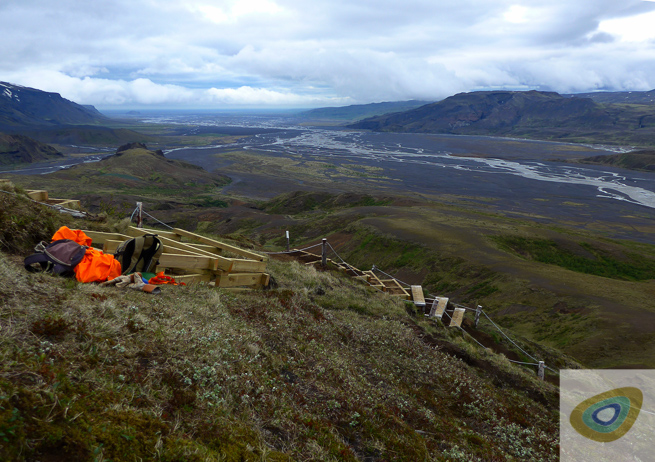
Iceland – The Land of Fire and Ice.
The island of Iceland sits on the mid Atlantic ridge and is geologically young. Massive volcanic activity has shaped this country into a land of extremes.
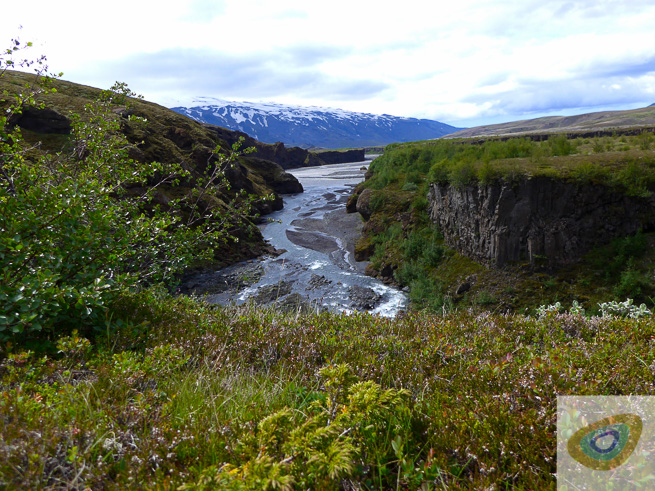
Two and a half hours drive from the capital city Reykjavík is Thorsmork. This area of Iceland is home to the Laugavegur, one of the most spectacular overland hikes in the world.

Thorsmork is host to many hiking trails besides the Laugavegur. This multitude of trail networks attracts lovers of the outdoors from everywhere.
These trails have grown up organically over time, but due to the heavy and increasing visitor numbers (1.5 million visitors in Iceland a year) and the soft volcanic ground, the paths need work to prevent erosion and further damage to the fragile landscape.
This vital work is carried out by the Icelandic Forestry Service in areas of Iceland. Chas Goemans works for the Forestry Service and runs teams of volunteers who provide the labour force for the work.
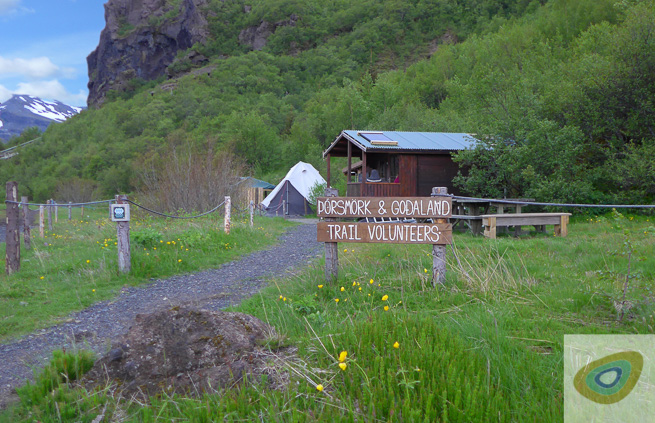
The Iceland Trail team was set up by Chas as a way of establishing a no fees volunteer program. This was first run as a pilot program in 2012 that went independent in 2013.
Between May 7th to mid-September, the trail team is based out of Langidalur, Básar and Hvanngil. Chas aims to have 25 people at any one time on the ground working in 4 teams. When I interviewed him for this article he said; “It leads to good group dynamics and is the maximum capacity for cohesion and management”. If the numbers exceed 25, then it becomes difficult to manage and it is hard for everyone to get to know one another.
Volunteer placements vary in length from as little as two weeks for those with less time, to placements of seven weeks for team leaders. Team leaders receive training on how to build good paths and how to manage and look after their team in a potentially dangerous environment.

The volunteers attracted to Thorsmork are an eclectic bunch and include students who are, or have studied, biology, botany, zoology, geography and sustainability to name but a few. Chas likes to have a real mix of people and age groups to make the teams more dynamic.

While stationed at one of the main base camps, spectacular views of the mountains come as standard to each tent pitch.

Given that Iceland is so remote and geologically young; it has no native ground based predators. This, along with the fact that most of the trees in Iceland are little more than shrubs, leads to birds nesting at about the same level as your knees. There is a local joke in Iceland – “what do you do when you get lost in an Icelandic forest?” – “stand up”! Most of the trees are dwarf species. Next to my tent was a small birch tree with a nest full of noisy newly hatched neighbours.
Iceland is 65 degrees north. This means that in the summer months it never really gets dark. I really enjoyed this aspect of the country. Having constant daylight was energising and meant that I had very little sleep while I was there and needed very little. It can, however, be quite disorientating for some, so do take an eye mask and ear plugs with you, because the birds never sleep either!
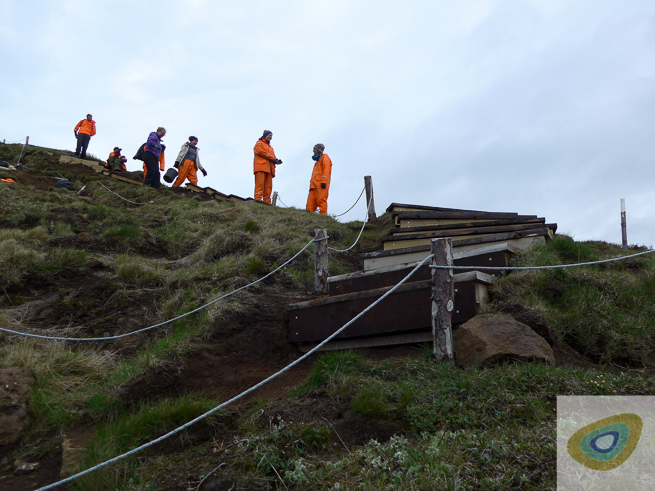
The work carried out by the trail teams includes; building stone and timber steps, cutting drains, placing way markers and signs, and erosion control measures like silt dams and seed planting.
Most of this work is carried out by hand with hand tools. As much as possible the materials used are found from within the local vicinity. The timber used in the work is provided by the Forestry service and is first phase thinning spruce. Off-road lorries and jeeps with trailers and grabbers are used to deliver the timber and then the trail teams prepare it. These deliveries typically happen twice a season.
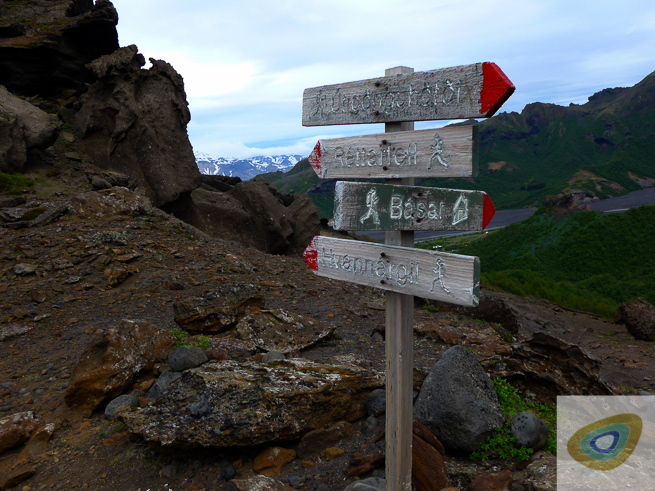
The weather in Iceland can be vicious – strong winds, heavy rain and snowfalls lead to the degradation of wooden signs and way makers. These signs need to be regularly checked and replaced; this work is one of the tasks carried out by the trail team.

Each block of two weeks is broken down into two parts – short range and long range weeks. Short range is when teams work on locations that can be reached within a few hours walk or less from the base camps where they are stationed. Long range is more expedition style and is focused on locations that are further away. This can be any range up to 40-45km away. Trail teams carry their food, camping gear and tools to an area for a week to work remotely. This is one of the most enjoyable parts for the volunteers as they get to work in truly isolated wilderness areas.
Building Hiking Trails – Long Range

For my long range trip, 10 of us hiked up the Laugavegur with all the equipment we needed to live and work remotely. Even with clear sunny skies the wind keeps the temperature feeling low, so warm jackets and sun screen go together.
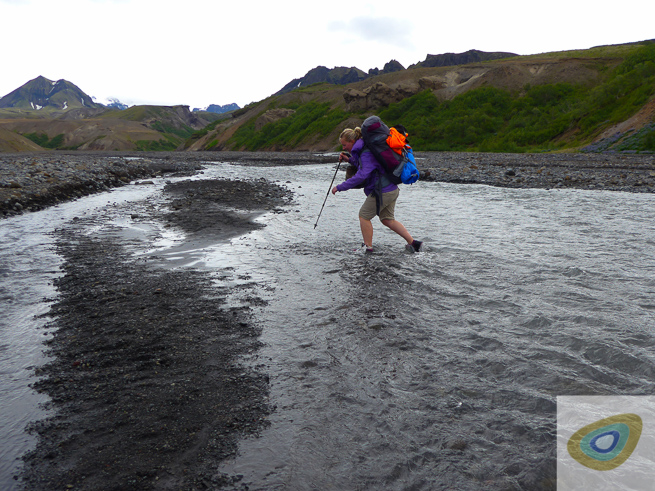
On the way out to our long range location we had several rivers to cross, so having a pair of river crossing shoes or trainers with you is a good idea. Hiking with wet boots and socks is a great way to invite blisters into your life, and crossing barefoot is not advised.
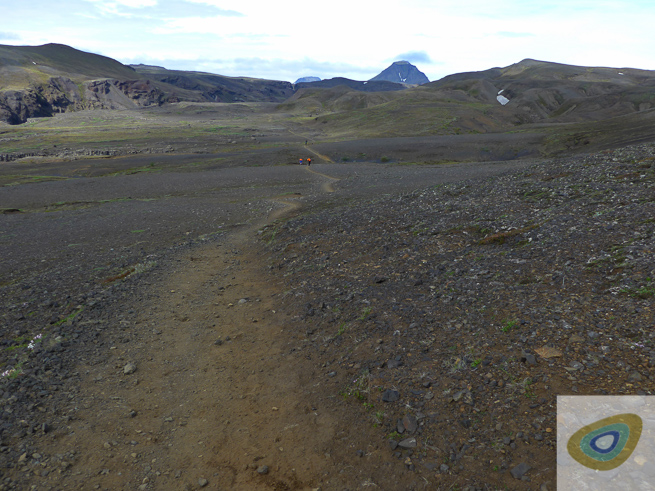
Laugavegur trail, due to its fame, experiences some of the heaviest traffic from hikers in the area. Hence, it needs a fair bit of work. The main aspect of our work was to build rock steps and drains in areas with steep inclines. Due to the dusty volcanic soil, the impact of hiking in these areas can be difficult to control.

There are many ways to build rock steps. Generally, it is best to use the biggest stones you and your team can carry. The larger the rock, the less likely it is to shift underfoot and become unstable. We used team work to move huge rocks into place, strapping them to poles and getting four people to carry them at once.
Bedding these stones into place is another skill; the deeper the stones are dug in, the more solid they will be and the longer they will last. It is all about slope stabilisation, so the stone is best buried lengthways with the smallest face as the step surface.
The next trick is to get people to walk where you want them to walk. We are all energy efficient hikers looking for the easiest way to get from A to B. If the rock steps are built correctly they will invite you to walk up them, the last thing you want is to make it more difficult for people to hike up the steps than go around them. If this does happen it will lead to heartbreak, as you see the hard work that has been put in, go to waste and slope destabilisation. In this case, we made rock piles either side of the steps to funnel people up the steps.

The greatest part of the trip was meeting people and making friends. Everyone must work together to succeed at such tasks and this made us strong teams. The Forestry Service provided the orange overalls to help keep us dry and stop our own clothes from getting trashed. They did make us stand out on the landscape as well, it’s better to seen in environments like this.
I am a keen hiker, and before this trip I had thought little of how much work goes into building trails. The work done by the trail teams in Iceland, the United Kingdom and all around the World is invaluable and I am pleased to have shared a little of it with you in this article.
It was great to see the goodwill that was shown between the trail teams and all the tour companies, NGO’s, and guides. The work done by the teams does not go unnoticed. Warm thanks and gifts are exchanged regularly. Assistance is offered by the local bus companies who give free travel to the volunteers and the local suppliers do what they can to help.
The work is carried out in a conscientious way; low impact is the aim. As Chas mentioned when I spoke to him – “the trick is to tread lightly and improve things without losing what you see”.

Iceland is one of the most stunning countries I have visited, full of character and mystery. Like mainland Scandinavia, many of the residents believe in Elves, Trolls, and Goblins. Once you have spent time in the country you can understand why. J.R.R. Tolkien, author of The Lord of the Rings, among other titles, was influenced by the stories of Trolls from Iceland and the Icelandic language.

I hope you enjoyed reading this article! I can’t recommend going to Iceland more highly.
Takk
Latest posts by Henry Landon (see all)
- A Springtime Feast: Cooking Up A Treat In The Woods - April 22, 2020
- Getting Fit For Your Next Adventure - April 10, 2020
- The Value of Carrying a Rope While Hiking - June 6, 2017

Dave Howard
Hi Henry, Thanks for sharing your experience, and for volunteering to do this work. A task without which I am sure the beauty of Iceland would soon be lost among the footprint of the adventurers, the inquisitive and the ravages of the climate. You must have felt as if you had woken up in Lilliput on emerging from your tent to knee-high trees. Well written and informative, I enjoyed this piece a lot, thanks Paul for posting this.
All the best, Dave.
Henry
Hi Dave,
Thanks for your comment, I’m pleased you liked the article. Iceland is a popular desitination for lovers of the outdoors, the work done by the volunteers is important for preserving the trails for the future and they always need more people to help. The trees are small where I was camping and did feel out of proportion compared to the trees back in the UK, but it was the birds that nested at knee height.
Thanks again,
Henry